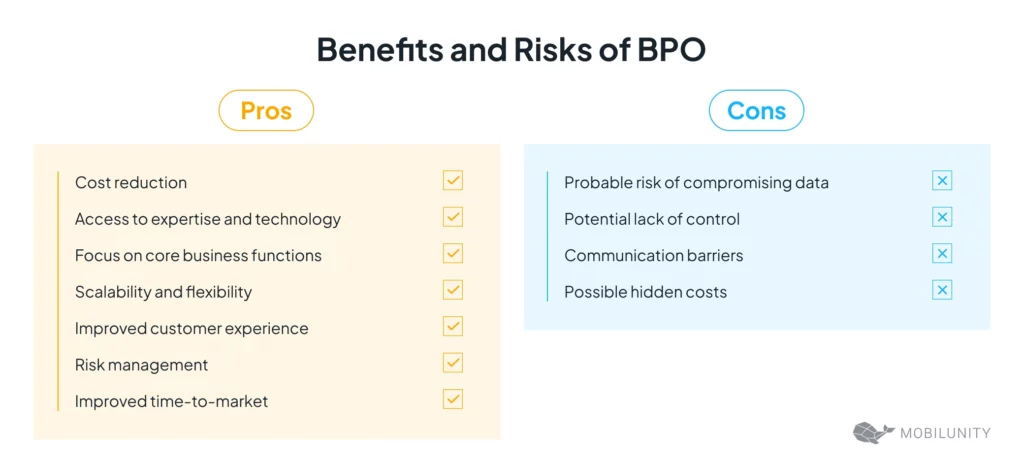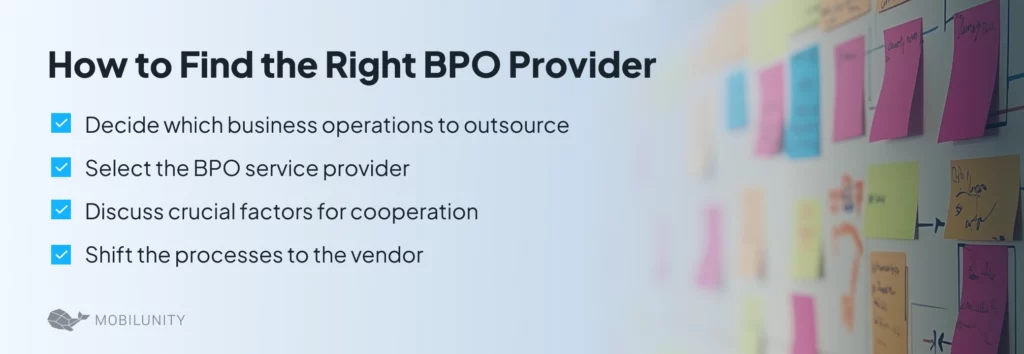Business Process Outsourcing (BPO): The 2025 Guide
Being a dedicated development team provider for over a decade, Mobilunity has embraced many aspects of Business Process Outsourcing.
From this guide, you’ll learn the definition of BPO, understand how it works, explore its types, benefits, drawbacks, and trends, and check the costs.
Additionally, we’ll advise on how to find a reliable partner and share some of Mobilunity’s case studies to explain how we approach customers’ challenges and offer beneficial solutions.

Understanding BPO and Its Market Size
BPO stands for business process outsourcing. While outsourcing means hiring external specialists to perform certain tasks, Business Process Outsourcing is when an organization contracts another company to run the entire business function on its behalf.
It can include accounting, data annotation, sales, marketing, human resources, call centers, recruiting, etc.
A BPO vendor can offer more than one type of service; however, each function is supported by domain experts.
Subcontracting partners appeared in the mid-20th century in the manufacturing industry. Then, companies outsourced non-core business functions like procurement, component production, supply chain management, etc.
With the rise of globalization and industrialization, businesses have used external firms to decrease expenses and focus on innovation and product development.
How Big Is the BPO Industry?
The BPO market grew from $267.72 billion in 2023 to $291.97 billion in 2024. It’s expected to continue growing at a CAGR of 9.74% and reach $513.26 billion by 2030. (Researchandmarkets)
Finance & accounting, customer services, human resources, procurement and supply chain, and sales and marketing remain the most popular outsourcing fields in the US, according to Grandview Research. The top BPO destinations are the Philippines, India, Poland, Ukraine, Brazil, Vietnam, Malaysia, and Mexico.

Benefits of BPO and Its Limitations
Let’s first explore the benefits of business process outsourcing:
Cost Reduction
BPO assumes transferring tasks to contractors from countries with lower labor costs and taxes, which results in significant savings compared to running these business activities in-house.
Additionally, due to economies of scale, you minimize overheads like infrastructure and utility. BPO partners manage technology upgrades and staff training, enabling businesses to save on tech stack, resource allocation, and training.
Access to Expertise and Technology
Business process outsourcing can help you engage professionals with extensive industry knowledge who unburden you from routine responsibilities. These experts use advanced tools and implement best practices to deliver effective and accurate solutions.
Focus on Core Business Functions
Often, overqualified or multiskilled professionals handle payroll processing, customer support, data annotation, etc., because companies don’t have separate teams for these routine tasks. By shifting them to specialists, you can redirect your resources to product development, innovation, and market expansion.
Outsourcing non-core functions to experts minimizes distractions for your leaders, enabling them to focus on long-term success and improving competitiveness.
Scalability and Flexibility
Resource scalability is one of the most prominent benefits of outsourcing work, as subcontractors can rapidly scale activities up and down during seasonal spikes, market expansions, or unforeseen changes.
When outsourcing, you typically get a customized solution with the needed service level, contract terms, and delivery models tailored to your requirements.
Enhanced Process Efficiency
No matter which function you externalize, your company would benefit from outsourcing and get enhanced performance due to domain-focused expertise, advanced technologies, and streamlined processes.
Professionals will reduce errors, optimize tasks, and accelerate turnaround times while providing consistent service quality. So, businesses can allocate resources more efficiently and boost their productivity.
Risk Management
Out-tasking to top experts can help reduce the risk of legal or financial penalties, protect sensitive customer and company information from breaches, and ensure business resilience during diverse disruptions.
Experienced providers mitigate process inefficiencies and errors, minimizing the risks related to service quality or delivery timelines. Additionally, businesses can scale operations without the risk of overextending their own resources.
Improved Time-to-Market
Outsourcing companies help organizations speed up workflows and reduce bottlenecks. They also provide access to niche-skilled professionals, avoiding delays caused by recruiting and training.
By delegating operational tasks, businesses can focus on expediting the product’s market readiness and establish networks that accelerate market expansion.
Risks of Outsourcing
Despite the many benefits of outsourcing, it also comes with certain risks and challenges. BPO is often associated with the following issues once you partner with an inexperienced company. Below, we’ll share how to avoid unproven vendors and find a reliable outsourcing provider.
| Drawbacks to BPO | Description |
| Probable risk of compromising data | Externalizing activities exposes businesses to potential data breaches, financial losses, reputational risks, and regulatory penalties |
| Potential lack of control | Companies risk compromising service quality, data security, compliance, and operational efficiency |
| Communication barriers | Can lead to misunderstandings, reduced service quality, customer dissatisfaction, and misaligned expectations |
| Possible hidden costs | Onboarding, training, or unexpected fees can strain budgets, reduce cost-efficiency, and erode trust, impacting profitability |
If not appropriately addressed, the challenges of shifting functions to third parties can harm business continuity, damage reputation, weaken clients’ trust, and lead to financial losses.
Types of BPO Models
BPO addresses diverse business needs by offering solutions based on geographic location, nature of delegated tasks, and operational structure.
The classification below will help you choose the right outsourcing strategy for efficiency and growth.
Location-Based BPO Models
The following BPO formats are categorized based on proximity to the client and address cost, communication, and cultural considerations.
| Factors | Onshore Outsourcing | Nearshore Outsourcing | Offshore Outsourcing |
| Location | The same country as the client | Neighboring or nearby country | Distant countries, often in different continents |
| Costs | High | Moderate | Low |
| Communication and cultural alignment | Seamless | Manageable language barriers and cultural differences | Manageable language barriers and cultural differences |
| Ideal for businesses that prioritize | – Data security – Compliance – Effective team collaboration | – Communication quality – Activities requiring cultural sensitivity – Synced collaboration | – Significant cost savings – Extended business hours – Scaling operations |
Models Based on the Outsourced Tasks’ Nature
The table below compares the two outsourcing models across the seven key criteria that will help businesses understand their purposes.
| Criteria | Front-Office BPO | Back-Office BPO |
| Focus | Customer-facing functions, enhancing their experience and engagement | Internal business functions supporting the company’s operational efficiency |
| Examples | Customer service, sales, tech support, marketing | IT support, data entry, accounting, payroll |
| Impact on Business | Directly influences customer satisfaction and brand perception | Indirectly contributes to operational efficiency and productivity |
| Expertise Requirements | Communication skills, empathy, cultural understanding | Process optimization capabilities, technical expertise |
| Scalability | Crucial for fluctuating customer demands or seasonal spikes | Vital for expanding activities and managing data growth |
| Technology Needs | CRM systems, AI-powered chatbots, analytics for customer insights | ERP systems, automation tools, and cloud platforms for process optimization |
| Cost Considerations | Costs depend on the demand spikes but are tied to the quality of customer interactions | Typically stable costs that can be cut through automation |
Now, let’s explore the examples of services provided under each model.
Front-Office Services
- Customer relations. These services include professional support, inquiries, and complaint resolution through phone, chat, email, and social media. With skilled teams and advanced tools, providers guarantee high-quality customer experiences.
- Marketing. SEO, PPC, social media administration, media content development, outreach campaigns, lead generation, market research and analytics, and digital marketing software creation are what marketing services outsourcing involves. Such a solution boasts scalability, cost-efficiency, and access to expertise.
- Sales. A BPO provider that specializes in sales offers lead generation and qualification services, outbound and inbound sales calls, running customer retention and renewal campaigns, creating upselling and cross-selling strategies, and providing sales analytics and reporting.
- Tech support. Helpdesk teams troubleshoot software or hardware issues for your product users, guide them through installations or updates, and provide solutions for service disruptions. By addressing tech concerns effectively, IT service teams keep customer satisfaction high.
Back-Office Services
- Accounting. These services include bookkeeping and payroll management, payment processing, tax preparation and compliance, financial reporting and analysis, managing accounts payable and receivable, and budgeting and forecasting — all with precision and adherence to regulations.
- Recruiting. Tech hiring professionals provide talent sourcing and screening, conduct technical interviews, run background checks, and ensure onboarding support. They also can handle workforce planning and employer branding. Accelerated hiring, access to global talent, and deep expertise allow businesses to reduce recruitment expenses.
- Legal. Legal process outsourcing covers contract drafting and review, legal research and case preparation, intellectual property management, document review and e-discovery, and compliance monitoring and risk assessment. Consultants with niche-specific skills will accelerate legal processes and ensure compliance with industry regulations.
- Quality Assurance. QA refers to outsourcing software testing, test planning, execution, and reporting, automation testing and tool implementation, bug tracking and resolution, and UX and usability testing. With expert quality assurance, organizations streamline the debugging process, speeding up product launches and optimizing expenses.
- Development services. When companies want to reduce in-house development expenses, access tech talent, and leverage scalability, they can outsource tasks like software and web development. These also include mobile app creation and maintenance, UI/UX design and prototyping, and custom software solutions and integrations.
- Data annotation. Once you need image and video labeling for AI/ML models or text annotation for NLP, choosing a BPO supplier specializing in data annotation will give you high-quality datasets. This supplier can perform audio transcription and tagging for speech recognition, 3D point cloud annotation, quality control, and dataset management.
BPO Models Based on the Operational Structure
The following models vary in their approach to subcontracting tasks and differ in flexibility, risk allocation, and alignment with business goals.
Process-Based Outsourcing
Process-based outsourcing means shifting specific, well-defined tasks like payroll, IT helpdesk, or customer support functions to an external company. Such companies rely on streamlined workflows and best practices and easily adjust to changing volumes or business needs.
Shared Services Outsourcing
With this model, large, multi-unit organizations centralize business functions to serve multiple divisions or clients from a single point. Companies outsource business processes like finance, HR, IT support, procurement, etc., promoting efficiency, consistency, economies of scale, and uniformity.
Build-Operate-Transfer (BOT)
This type of BPO involves outsourcing assistance with the goal of getting ownership. The contractor sets up infrastructure, recruits staff, and establishes processes. They align operations with a client’s business goals and transfer them after gaining stability.
Outcome-Based BPO
The vendor’s compensation is tied to achieving pre-agreed performance metrics (outcomes), encouraging providers to coordinate priorities with the client’s objectives, and ensuring efficient process management. This format requires transparent communication, shared responsibility, and focus on results.
Examples of Business Process Outsourcing
As a BPO vendor, we’d love to share some of our case studies to demonstrate how a customer-centric approach and fast, high-quality recruiting, help us craft suitable solutions for you.
Video Annotation for a UAE Research Institution
The company needed to annotate video frames with heatmaps for their computer vision project. Since multiple data labelers were supposed to work on the same dataset, consistency in identification was crucial.
Mobilunity-BPO quickly built a team of three seasoned heatmap data labeling experts and customized their annotation platform. We aligned with the client’s requirements and established data quality assurance.
Our annotators processed nearly 18,000 frames across six datasets for 293 hours and delivered a high-quality dataset within pre-agreed terms.
Pafin: Online Research for a Japanese FinTech Service Provider
Pafin reached out to us for a data research specialist well-versed in web3, cryptocurrencies, finances, and investment. This expert was supposed to process 1,000+ entities with additional values within two weeks.
Considering the short turnaround time and demanding quality criteria, Mobilunity-BPO found a data labeling specialist with web3 and NFT expertise. After completing the small part of the task and confirming understanding of the instructions, our specialist completed the project in 9 days.
Mobilunity-BPO engaged a Japanese-speaking manager and regularly updated the client on the progress. It enabled us to accomplish the data collection task in time and without major revisions.
“We are very satisfied with the quality of services provided by the Mobilunity-BPO team and flexibility in adjusting to our needs. This cooperation allowed us to release the product faster and optimize the budget.”
Shunsuke Masuda, Co-Founder and Managing Director at Pafin.
Drug Patent Image Annotation for a South Korean Biotech Research Company
Our client needed bounding box annotation for a set of drug patent images. The challenge was to find labelers well-versed in chemistry to distinguish atomic reactions.
Mobilunity-BPO’s recruiters thoroughly vetted tagging specialists with the needed expertise and built a team of four. We also introduced cross-checking to reinforce verification and maintain consistency.
Our team marked 20,000 PDF files and finalized the project in just two weeks, having demonstrated commitment and readiness to tackle difficulties.
9 Trends in the BPO Market
The BPO industry is evolving rapidly, driven by tech advancements, changing business needs, and the global business process outsourcing market dynamics.
Let’s explore trends that shape the future of the outsourcing sector.
1. Adoption of AI
Artificial Intelligence is revolutionizing the industry, enabling the automation of repetitive tasks, enhancing efficiency, and reducing costs.
ML-driven predictive analytics allow for better decision-making and improve customer interactions.
With AI developers, suppliers can offer faster, scalable, and reliable solutions while maintaining high operational efficiency. This allows businesses to prioritize strategic development.
2. Robotic Process Automation (RPA)
Robotic bots make business process automation possible by handling rule-based tasks like data entry, customer onboarding, invoice processing, etc.
External providers hire RPA developers to automate your business processes, reducing human errors and delivering accurate solutions quickly.
RPA lets providers handle high-volume tasks and scale processes without significant cost increases. Its integration with AI further optimizes workflows, making outsourcing partnerships more competitive.
3. Emphasis on Data Security and Compliance
Increasing cyber threats and stringent regulatory requirements make data security and compliance critical for service suppliers.
Providers often hire Python developers to protect sensitive data. They help implement advanced security protocols, data encryption, multi-factor authentication, and periodic vulnerability assessments.
They also align operations with regulatory frameworks, frequently update compliance policies and run audits, train employees, and obtain certifications like ISO 27001 and SOC2 for credibility.
4. Knowledge Process Outsourcing (KPO)
KPO engages highly skilled, niche professionals like engineers, analysts, legal advisors, financial experts, market researchers, and others.
The demand for KPO reflects the shift toward knowledge-intensive tasks that add strategic value without compromising budget or quality.
For example, large healthcare or finance organizations can hire Objective C developers to create enterprise-scale iOS apps, customize macOS software, or enhance user experience or security in existing applications.
5. Expansion of Global Capability Centers (GCCs)
GCCs that are also known as Global In-house Centers are centralized hubs established by multinational corporations to consolidate and optimize workflows.
Traditionally viewed as cost-effective back-office centers, GCCs have evolved into strategic assets, driving innovation and creating value by handling mission-critical tasks.
GCCs handle different processes, including finance and accounting, software development, data analytics, HR, customer support, procurement, and R&D.
6. Offshore Development Centers (ODCs)
With the rise of technology-driven offshore outsourcing, ODCs and OSDCs (Offshore Software Development Centers) have achieved recognition. While ODCs focus on a wide range of development tasks, OSDCs handle software creation and related activities.
OSDCs assume contracting dedicated development teams for application development, IT infrastructure management, testing and quality assurance, custom software development, and integrations and updates.
7. Focus on Customer Experience
When shifting certain functions to BPO companies, businesses expect to deliver customized and value-bringing solutions to their customers.
AI and analytics offer end users personalized interactions, anticipate their needs, and ensure consistent experience across multiple platforms, etc.
For instance, with Flutter developers, vendors can create visually appealing and responsive apps for diverse industries.
Additionally, external partners focus on adjusting resources to embrace fluctuating customer demands during peak periods, ensuring uninterrupted operation.
8. Shift Toward Outcome-Based Pricing Models
The growing demand for accountability, performance, and alignment between the company and the BPO dealer promotes the popularity of outcome-based cooperation.
The main drivers for the shift are the need for greater transparency and ROI from outsourcing while advanced analytics enable precise tracking of outcomes.
Competitive markets push vendors to innovate and deliver measurable results, granting cost-efficiency, alignment of goals, and optimized processes.
9. Switching to Cloud Infrastructure
The necessity of scalability, flexibility, and cost-efficiency motivates providers to adopt cloud-based solutions. Cloud infrastructures let them improve delivery time and meet evolving client demands.
Increasing adoption of remote work and virtual collaboration, the urge for real-time data access for global teams, and advancements in cloud security are the drivers for the trend.
For businesses that outsource work to cloud-adopting providers, it means faster onboarding of functions, enhanced team collaboration, and service delivery with minimal downtime.
BPO Cost in Diverse Locations
The price for external services depends on the provider’s location, type of outsourcing services, volumes of work, workforce expertise, tech stack, adherence to strict regulations, contract length, etc.
We’ve filtered back office outsourcing companies on Clutch and found the top 25 providers are based in the US, the UK, UAE, and popular offshore BPO locations like the Philippines, Ukraine, Colombia, Poland, Mexico, and India. While some companies don’t disclose their rates, the majority of providers quote a fee of up to $25 per hour.
The platform shows the average hourly cost of less than $25 for data entry, payment processing, legal assistance, document digitization, and claims handling, while out-tasking finance and accounting (FAO) costs $25-$49.
Finding the Right BPO Provider
The features of your BPO solution will depend on the required functions, the location of your supplier, and the cooperation model.
Here’s how partnering with an external contractor looks in four steps.
1. Decide Which Business Operations to Outsource
Identify non-core, resource-intensive tasks that require time and money but don’t directly contribute to your business’s competitive advantage.
Define the processes requiring specialized expertise and technology and assess potential cost savings and scalability needs. Prioritize outsourcing the tasks that will let your employees focus on growth-driving activities.
Consider the location of your future outsourcing partner in terms of the comfortable time zone and cultural fit, evaluate the budget, and assess the terms of cooperation.
2. Select the BPO Service Provider
Look for organizations that meet your criteria, ensuring they have experience in your field and a proven track record. Check their reputation, customer reviews, relevant case studies, and talk to their clients. Grade the selected companies and choose a few ones with the highest scores.
Explore their workflow infrastructure, tech stack, data security measures, and compliance with regulations. Assess their scalability, fit for your operational needs, and flexibility.
3. Discuss Crucial Factors for Cooperation
You need to align expectations before finalizing the partnership with your BPO vendor, focusing on these aspects:
- Cost and pricing models. Understand the fee structure, contract flexibility, additional charges for service extension, and possible hidden fees.
- Cultural alignment. Check if their values and work ethics are compatible with yours.
- Performance metrics. Outline accountability measures and timelines.
- Communication. Establish clear points of contact, response times, and reporting structures.
4. Shift the Processes to the Vendor
Craft a thorough transition plan with terms, milestones, and resources. Address potential challenges like data migration, knowledge transfer, and compliance requirements.
Assign in-house specialists to assist with the transition phase, share workflows and tools with the partner, and agree on feedback sessions and collaborative problem-solving.

Final Words
BPO will continue to evolve as a powerful strategy for businesses in 2025, driving efficiency, scalability, and innovations.
Organizations can make informed outsourcing decisions and unlock new growth opportunities by understanding outsourcing formats, benefits, limitations, and trends. Meanwhile, businesses can focus on core activities in a competitive global market.














Company’s CTO
“Our partnership with Mobilunity-BPO has not only met our expectations but exceeded them. The precise annotations, seamless teamwork, and adherence to our unique requirements have accelerated our computer vision research.”